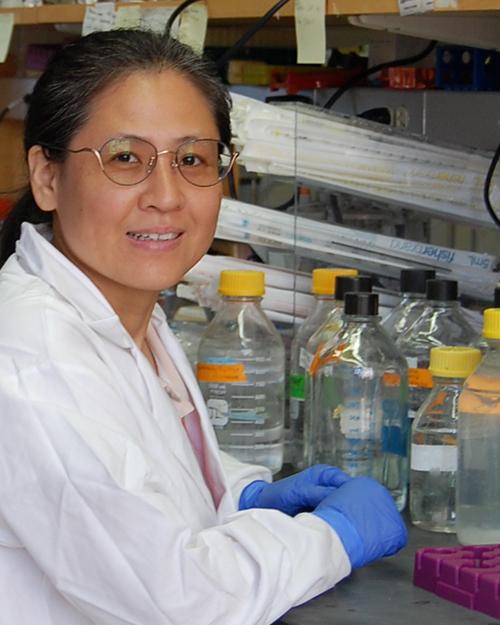
Loranne Magoun
Laboratory Manager
Email: loranne.magoun@tufts.edu
Education:
- BA, Biology, St Mary’s College of Maryland, St Mary’s City, MD
- MS, Labor Studies, University of Massachusetts – Amherst, Amherst, MA
Research:
I have been a part of the Leong Lab since 1994 and participate in both the managerial and research aspects of our work. I bring my background as a labor organizer to help build community between our work teams and solve operational issues. I am attuned to inefficiencies and often lend technical support to projects that are undergoing a particularly labor-intensive phase.
I manage the operations and information flow in the lab and am currently assisting the Lyme work. I otherwise focus my efforts on the E. coli projects. My current goal is to finish the preclinical study for the Bill and Melinda Gates Foundation on Iron Supplementation. It has been seen that people undergoing insoluble iron supplementation often suffer additional bacterial infections. In part, this work will analyze the effects of 2 new forms of soluble iron supplementation on the growth of pathogens, using patient serum samples taken at 0 hours and 4 hours post-prandial. Phase I (150 patients) has been completed and the remainder of Phase II (75 patients) will be performed in the coming year.
Atri Ta
Postdoctoral Scholar
Email: Atri.Ta@tufts.edu
Education:
- BSc, Animal Science & Biotechnology, PSG College of Arts and Sciences, Coimbatore, India
- MSc, Biotechonology, Bharathidasan University, Tiruchirappalli, India
- PhD, Biotechnology, University of Calcutta, Kolkata, Indial
Research:
Enterohemorrhagic Escherichia coli (EHEC) is a human enteric pathogen that cause intestinal illness, but in susceptible individuals it results in serious complications including hemorrhagic colitis and hemolytic uremic syndrome (HUS). EHEC colonizes the colonic epithelial cells and produces Shiga toxin, which causes systemic disease. My research focuses on understanding how shiga toxin translocate across the intestinal barrier into the blood and to the other target tissues.
Chenyi Chu
Postdoctoral Scholar
Email: Chenyi.Chu@tufts.edu
Education:
- BS, Preventive Medicine, School of Medicine, Zhengzhou University, Zhengzhou, China
- PhD, Epidemiology & Health Statistics, Beijing Institute of Microbiology & Epidemiology, Academy of Military Medical Sciences, Beijing, China
Research:
My research focuses on the identification of surface lipoproteins of the Lyme disease spirochete (Borrelia burgdorferi sensu lato) that influence tropism for vertebrate host species and tissues, with the aim to identify microbial determinants of disseminated infection by B burgdorferi in both humans and reservoir animals.

Danielle Butler
Research Technician
Email:
Danielle.Butler@tufts.edu
Education:
- BS, Biology & Chemistry, St. Michael’s College, Colchester, VT
Research:
In addition to providing logistical support, I am involved in the characterization of surface proteins of the Lyme disease agent, Borrelia burgdorferi, that promote disease in the mammalian host by mediating resistance to immune defenses or attachment to tissues. I also investigate the delivery of Shiga toxin from the intestine to extraintestinal tissues by enterohemorrhagic Escherichia coli.
Devyn Yolda-Carr
PhD Student in Molecular Microbiology – MERGE-ID
Email:
Devyn.Yolda_Carr@tufts.edu
Education:
- BS, Molecular Genetics, University of Vermont, Burlington, VT
Research:
I am just beginning my thesis research in the Leong lab.

Linda Xu
Ph.D. Graduate Student in Immunology
Email: shuying.xu@tufts.edu
Education:
- AB, Biochemistry, Mount Holyoke College, Hadley, MA
Research:
Streptococcus pneumoniae is a major cause of pneumonia, wherein infection of respiratory mucosa drives a robust influx of neutrophils into the airways, followed by tissue damage and lethal septicemia. Pneumolysin is a major S. pneumoniaevirulence factor that generates ~25 nm diameter pores in eukaryotic membranes, promoting acute inflammation, tissue damage, and bacteremia. My research focuses on damage to epithelial integrity and promotion of bacterial dissemination during S. pneumoniae infections, specifically, looking at if neutrophil transmigration and bacterial pore forming toxins play any roles.

Rhiju Tamang
Research Technician
Email: Rhiju.Tamang@tufts.edu
Education:
- BS, Biology, Colby-Sawyer College, New London, NH
Research:
Borrelia burgdorferi is the causative agent of Lyme disease. This spirochete encodes more than 80 surface lipoproteins that mediate interactions with the host environment. I am modifying a B. burgdorferi expression library generated by Wolf Zuckert and coworkers that encompass the surface lipoproteome. I will screen the library to identify surface lipoproteins that promote interaction with host environment.

Tianmou (Tony) Zhu
Ph.D. Graduate Student in Immunology
Email: Tianmou.Zhu@tufts.edu
Education:
- BA, Biology: Cell Biology, Molecular Biology, and Genetics, Boston University, Boston, MA
- MS, Bioinformatics, Tufts University, Medford, MA
Research:
I am just beginning my thesis research in the Leong lab.
Leong Lab Alumni
Ph.D. Students
Hui Liu, 2000. “Intimin-Tir Interaction in Enterohemorrhagic E. coli.” Current position: Litigator at Mauriel Kapouytian Woods LLP for Intellectual Property and US-China dispute resolution.
Ken Campellone, 2003. “Actin Pedestal Formation on Mammalian Cells by Enteropathogenic Escherichia coli: A Dissertation. Current position: Associate Professor, Molecular & Cell Biology, University of Connecticut.
Padhma Radhakrishnan, 2004. “Role of Intimin and Tir in Actin Pedestal Formation by Enteropathogenic and Enterohemorrhagic Escherichia coli.” Current position: Principal, Beehive Scientific Consulting.
Josh Fischer, 2005. “Mechanisms of Host cell Attachment by the Lyme Disease Spirochete.” Current position: Principal Research Entomologist, Bayer Crop Science.
Pamela Joyce Savage, 2007. “ Rethinking Mechanisms of Actin Pedestal Formation by Enteropathogenic Escherichia coli in the Context of Multiple Signaling Cascades: a Dissertation.” Current position: SVP, Creative Director at Area 23, NYC.
Michael John Brady, 2008. “Mechanism and Function of Actin Pedestal Formation by Enterohemorrhagic Escherichia coli O157:H7: A Dissertation.” Current position: Department Head, Vitro Services at Toxikon Corporation, Haverhill, MA.
Brian Michael Skehan, 2009. “Functional Elements of ESPFU, an Enterohemmorhagic E. coli Effector that stimulates actin assembly.” Current position: Child and Adolescent Psychiatrist, U Mass Memorial Medical Center.
Robyn Lynn Marty-Roix, 2010. “T Cells Aid in Limiting Pathogen Burden and in Enhancing B1 and B2 Cell Antibody Responses to Membrane Glycolipid and the Surface Lipoprotein Decorin Binding Protein A During Borrelia Burgdorferi Infection.” Current position: Principal Medical Writer, Boston Scientific.
Vivian May Benoit, 2010. “Host Cell Attachment by Lyme Disease and Relapsing Fever Spirochetes.” Current position: Content Scientist, Roche.
Nang H. Maung, 2011. “Intranasal Colonization by Streptococcus pneumoniae Induces Immunological Protection from Pulmonary and Systemic Infection.” Current position: Deputy Director, Coronavirus Science Branch at California Department of Public Health
Emily Mallick, 2012. “A New Murine Model for Enterohemmorhagic Escherichia coli Infection Reveals that Actin Pedestal Formation Facilitates Mucosal Colonization and Lethal Disease.” Current position: Head of MOA Discovery, Invaio Sciences.
(Cindy) Yushuan Lai, 2014. “ESPFU, an Enterohemmorhagic E. coli Secreted Effector, Hijacks Mammalian Actin Assembly Proteins by Molecular Mimicry and Repetition.” Current position: Project Manager, Scientist, Augmenta Bioworks.
Laurice Flowers, 2018. “A Highly Synchronous Murine Model for EHEC Infection Reveals Shiga Toxin Promotes Pathogen Spread and Systemic Disease.” Current position: CPEP Medical and Public Health Microbiology Fellow, Indiana University School of Medicine (Department of Pathology and Laboratory Medicine)
Sara Roggensack, 2019. “Identifying Age-related Immune Defects that Promote Susceptibility to Pneumococcal Pneumonia”. Current position: Research Scientist, Affinivax, Cambridge, MA. Pneumococcal vaccines.
Mike Pereira, 2019. “The Borrelia burgdorferi Lipoproteins ErpB and ErpQ Promote Spirochetal Binding to the Human Complement C1 Protein Complex and Inhibit Initiation of the Classical Complement Cascade”. Current position: Scientist II, Conagen.
Basma Joma, 2021. “Mouse Model Gone Viral: A Murine Model of Age-Related Susceptibility to Influenza-Streptococcus pneumoniae Co-infection” Current position: Research Scientist, Sanofi.
Valentina Studentsova, 2023.
Postdoctoral Researchers
Robert Kalish, M.D. 1990 – 1993. Longitudinal assessment of antibody responses by Lyme Disease patients. Current position: Assistant Professor of Medicine, Director, Rheumatology Education, Division of Rheumatology/Immunology, Tufts-New England Medical Center, Boston, MA.
Lina Moitoso de Vargas, Ph.D. 1990 – 1994. Host cell adhesion by the Lyme disease spirochete.
Jenifer Coburn, Ph.D. 1991 – 1995. Integrin binding by the Lyme disease spirochete. Current position: Professor, Medicine (Infectious Diseases) and Microbiology & Immunology; Center for Infectious Disease Research, Medical College of Wisconsin.
Hong Wang, M.D. Ph.D. 1994 – 1996. Recognition of host proteoglycans by the Lyme disease spirochete.
Nikhat Parveen, Ph.D. 1996 – 2005. Host cell attachment by the Lyme disease spirochete. Current position: Associate Professor, Department of Microbiology, Biochemistry and Molecular Genetics, Rutgers New Jersey Medical School, Newark, NJ.
Kishore Alugupalli, Ph.D. 1997 – 2005. T cell independent memory induced by the relapsing fever spirochete. Current position: Associate Professor, Department of Microbiology and Immunology, Sidney Kimmel Medical College, Sidney Kimmel Cancer Center, Thomas Jefferson University, Philadelphia, PA.
Kenneth Campellone, Ph.D., 2003 – 2005. Actin pedestal formation in EHEC infection. Current position: Associate Professor, Molecular & Cell Biology, University of Connecticut
Qiang Chen, Ph.D. Postdoc 2006 – 2008. Mammalian cell attachment promoted by the Borrelia burgdorferi fibronectin binding protein BBK32. Current position: SQL Developer at The TJX Companies, Inc. Wayland, Massachusetts.
Didier Vingadassalom, Ph.D. 2006-2010. Nck-independent actin pedestal formation by enteropathogenic E. coli. Current position: Sanofi Pasteur, Director, External Research & Development.
Kai Zhao, Ph.D., 2008 – 2008. Current position: Information Technology and Services (Financial Services).
Rudra Bhowmick, Ph.D. 2008 – 2014. Acute inflammatory pathways triggered by Streptococcus pneumoniae. Current position: Staff Scientist, City of Hope, Los Angeles, CA.
Yi-Pin Lin, Ph.D. 2010 – 2015. Bacterial recognition of extracellular matrix components during infection by the Lyme spirochete. Current position: Tenured Research Scientist IV, Wadsworth Center, Albany, NY.
Sivapriya Kailasan Vanaja, Ph.D. 2009 – 2014. Cytosolic detection of enterohemorrhagic E. coli. Current position: Assistant Professor of Immunology, University of Connecticut Health Center.
Sowmya Balasubramanian, Ph.D. 2011 – 2016. Mechanisms and consequences of Shigatoxin translocation across intestinal epithelium. Current position: Senior Scientist, Finch Therapeutics Group.
Felix J. Nepveux V, MD. 2017. Bacterial growth in human serum upon oral iron supplementation.
Elsa Bou Ghanem, Ph.D. 2011 – 2018. Age-related inflammatory mechanisms leading to invasive pneumococcal disease. Current position: Assistant Professor, Department of Microbiology and Immunology, University of Buffalo.
Walter Adams, Ph.D. 2015 – 2019. IRACDA (TEACRS) Fellow. Pneumolysin-mediated acute inflammation during pneumococcal lung infection. Current position: Assistant Professor, San Jose State University.
Beau Wager, Ph.D. 2015 – 2019. Lyme Disease – identification of Borrelia burgdorferi surface proteins that promote immune evasion or adhesion to host extracellular proteins. Current position: Investigative Lead, Zoetis Inc., Ft. Collins, CO.
Xi Qian, Ph.D. 2017 – 2020. MAP kinase signaling during Shiga toxin-mediated protein synthesis inhibition of renal podocytes. Current position: Biostatistical Analyst, Biopier Inc.
Yousuf Aqeel, Ph.D. 2018 – 2019, VHH antibodies to EHEC virulence factors. Current position: Evelo Biosciences.
Josh Quinn, Ph.D. 2020-2021. Identifying and characterizing bacterial genes associated with disease through molecular microbiology and high-throughput genomic analyses. Current position: Patent Agent, Cooley LLP.
Amanda Pulsifer, Ph.D. 2020 – 2022. The mechanism of Shiga toxin intestinal translocation. Current position: Senior Scientific Support Representative, STEMCELL Technologies.
Research Assistant Professor
Dakshina (Moody) Jandhyala, Ph.D. 2012 – 2016. Shiga toxin-induced ribotoxic stress response. Current position: Core Facility Manager, College of Pharmacy, University of Houston.
Medical Masters and Post-Baccalaureat Students
Andrew Cai. 2010 – 2011. (Tufts University School of Medicine). Role of calpain during epithelial cell effacement by enterohemorrhagic E. coli O157:H7.
Tim Blood, 2010 – 2011. (Boston University School of Medicine). Bacterial and host determinants of disease in a murine model of enterohemorrhagic Escherichia coli O157:H7
Charmaine Nganje, 2017 – 2019, Post-baccalaureate Research Education Program student, co-mentored by John Leong and Joan Mecsas. Current position: Research Associate, TCR Discovery, Gritstone Oncology.
James Nick Lee, 2018 – 2019. (Tufts University School of Medicine) “The immune checkpoint B7-H3 as a promising candidate to dampen colonic inflammation.” Current position: Student, Tufts University School of Medicine.
Lauren Laufer, 2018 – 2019. (Tufts University School of Medicine) “Understanding Clinical Manifestations of VAPI and Their Relationship to Epithelial Damage.” Current position: Student, Albert Einstein College of Medicine.
Technicians
Pamela (Morrissey) Glennon. 1991 – 1994. Current position: MD, orthopedic surgeon, Aspirus Wausau Hospital, Inc., Aspirus Medford Hospital & Clinics, Inc., and Oscar G. Johnson Veterans Affairs Medical Center, Wausau, Wisconsin.
Doug Robbins. 1996 – 2011. Retired.
Stacie Clark. 2012 – 2014. Current position: Scientist in Translational Biology at Senda Biosciences.
Haley Brin-Jones. 2014-2016. Current position: Senior Research Associate – Oncology. Moderna.
Anishma Shrestha. 2017 – 2020. Current position: Student, University of Detroit Dental School.
Nalat Siwapornchai. 2017 – 2021. Current position: Graduate Student Researcher at Harvard T.H. Chan School of Public Health
Visiting Professors/Scientists
Kyung Hee Park, M.D. 1995 – 1996. Assistant Professor of Microbiology, College of Medicine, Kon-Kuk University, Choongchungbuk-do, Korea. Cell adhesion by the Lyme disease spirochete.
Sarah Olken, Ph.D. 2016. Assistant Professor, Bunker Hill Community College. Colonic colonization and lethal disease during murine infection by Shiga toxin-producing Citrobacter rodentium.
Megumi Inomata, D.D.S./Ph.D. 2018 – 2019. Associate Professor, Department of Oral Microbiology, Asahi University School of Dentistry, Mizuho, Gifu, Japan. LC3-associated phagocytosis as an age-related defense against Streptococcal pneumoniae.
Shenglan Hu, Ph.D., 2019 – 2020. Scientist, Institute of Animal Science, Guangdong Academy of Agricultural Sciences, P. R. China. Therapeutic intervention during infection by a Shiga toxin-producing enteric pathogen.
Jacob Lemieux, M.D., Ph.D. Until 2023. Physician Investigator (Cl), Mass General Research Institute and Assistant Professor of Medicine, Harvard Medical School.
Visiting Graduate Students
Maria Teresa Almeida. 2009. Graduate student, laboratory of Sandra Sousa, Institute of Molecular and Cellular Biology, University of Porto, Portugal. Cell signaling by enteropathogenic E. coli and Listeria monocytogenes.
Anna Vind. 2019. Laboratory of Simon Bekker-Jensen, Faculty of Health and Medical Sciences, University of Copenhagen, Denmark. MAP kinase signaling by Shiga toxin produced by Enterohemorrhagic E. coli.
Jing Li. 2017. Laboratory of Jing-Ren Zhan, Tsinghua University, Beijing, China. Phase variation by Streptococcus pneumoniae.


